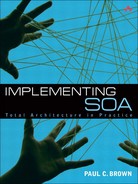Book Description
Putting Service-Oriented Architecture (SOA) into Practice
“This book is a must-have for enterprise architects implementing SOA. Through practical examples, it explains the relationship between business requirements, business process design, and service architecture. By tying the SOA implementation directly to business value, it reveals the key to ongoing success and funding.”
—Maja Tibbling, Lead Enterprise Architect, Con-way, Inc.
“While there are other books on architecture and the implementation of ESB, SOA, and related technologies, this new book uniquely captures the knowledge and experience of the real world. It shows how you can transform requirements and vision into solid, repeatable, and value-added architectures. I heartily recommend it.”
—Mark Wencek, SVP, Consulting Services & Alliances, Ultimo Software Solutions, Inc.
In his first book, Succeeding with SOA, Paul Brown explained that if enterprise goals are to be met, business processes and information systems must be designed together as parts of a total architecture. In this second book, Implementing SOA, he guides you through the entire process of designing and developing a successful total architecture at both project and enterprise levels. Drawing on his own extensive experience, he provides best practices for creating services and leveraging them to create robust and flexible SOA solutions.
Coverage includes
Evolving the enterprise architecture towards an SOA while continuing to deliver business value on a project-by-project basis
Understanding the fundamentals of SOA and distributed systems, the dominant architectural issues, and the design patterns for addressing them
Understanding the distinct roles of project and enterprise architects and how they must collaborate to create an SOA
Understanding the need for a comprehensive total architecture approach that encompasses business processes, people, systems, data, and infrastructure
Understanding the strategies and tradeoffs for implementing robust, secure, high-performance, and high-availability solutions
Understanding how to incorporate business process management (BPM) and business process monitoring into the enterprise architecture
Whether you’re defining an enterprise architecture or delivering individual SOA projects, this book will give you the practical advice you need to get the job done.
Table of Contents
- Copyright
- Preface
- About the Author
- I. Fundamentals
- 1. SOA and the Enterprise
- 2. Architecture Fundamentals
- 3. Service Fundamentals
- 4. Using Services
- 5. The SOA Development Process
- II. The Business Process Perspective
- 6. Processes
- 7. Initial Project Scoping
- 8. The Artifice of Requirements
- 9. Business Process Architecture
- 10. Milestones
- 11. Process Constraints
- 12. Related Processes
- 13. Modeling the Domain
- 14. Enterprise Architecture: Process and Domain Modeling
- Process and Domain Modeling Responsibilities
- Establishing Standards and Best Practices
- Managing Process and Domain Knowledge Transfer
- Reviewing Project Models
- Maintaining the Business Process and Domain Model Repository
- Defining Business Process Patterns
- Defining Common Data Model Representations
- Summary
- Key Enterprise Process and Domain Modeling Questions
- III. The Systems Perspective
- 15. Systems Architecture Overview
- 16. Top-Level Systems Architecture
- IV. Communications
- V. Data and Operations
- 20. Data Challenges
- 21. Messages and Operations
- 22. Data Consistency: Maintaining One Version of the Truth
- 23. Common Data Models (CDM)
- 24. Identifiers (Unique Names)
- 25. Results Validation
- 26. Enterprise Architecture: Data
- VI. Coordination
- 27. Coordination and Breakdown Detection
- 28. Transactions: Coordinating Two or More Activities
- 29. Process Monitors and Managers
- 30. Detecting and Responding to Breakdowns
- 31. Enterprise Architecture: Coordination
- VII. High Availability, Fault Tolerance, and Load Distribution
- 32. High Availability and Fault Tolerance Fundamentals
- 33. Stateless and Stateful Failover
- 34. Multiple Component Failover
- 35. Workload Distribution
- 36. Enterprise Architecture: Fault Tolerance, High Availability, and Load Distribution
- Business Process Categorization
- Information Storage
- Individual Component and Service Failover Patterns
- Composite Patterns for FT and HA Services
- Composite Patterns for FT and HA Business Processes
- Summary
- Key Enterprise Fault Tolerance, High-Availability, and Load Distribution Questions
- Suggested Reading
- VIII. Completing the Architecture
- 37. Process Security
- Security Information Classification
- Identity and Authentication
- Authorization
- Encryption
- Digital Signatures
- Other Security-Related Requirements
- Reference Data Servers and Performance
- Trust Zones
- Channel Enforcement
- Zone Enforcement and Policy Agents
- Multi-Zone Security
- Summary
- Key Security Questions
- Suggested Reading
- 38. Process Monitoring
- 39. Architecture Evaluation
- 40. Testing
- 37. Process Security
- IX. Advanced Topics
- 41. Representing a Complex Process
- 42. Process Management and Workflow
- 43. The Enterprise Architecture Group
- Afterword
